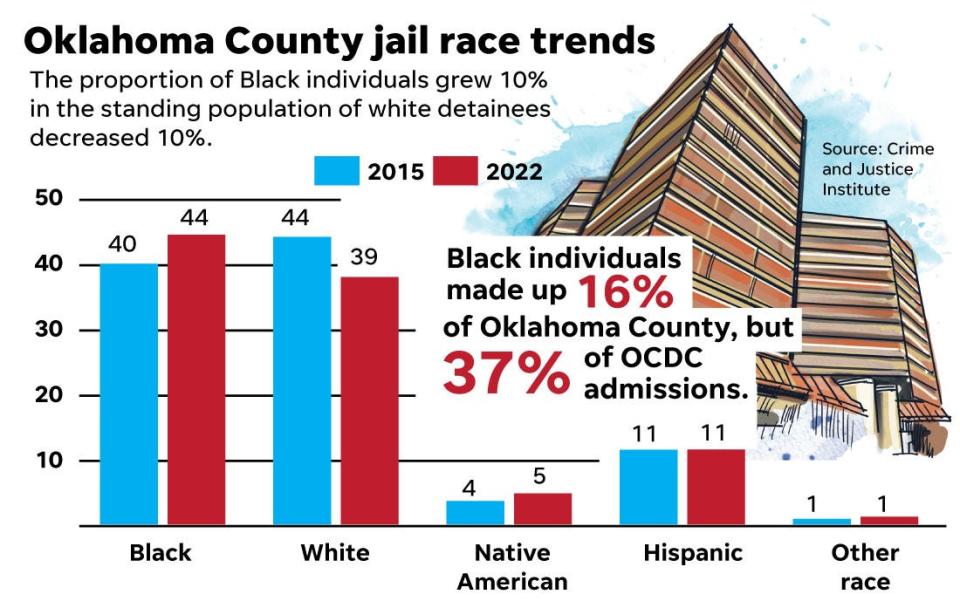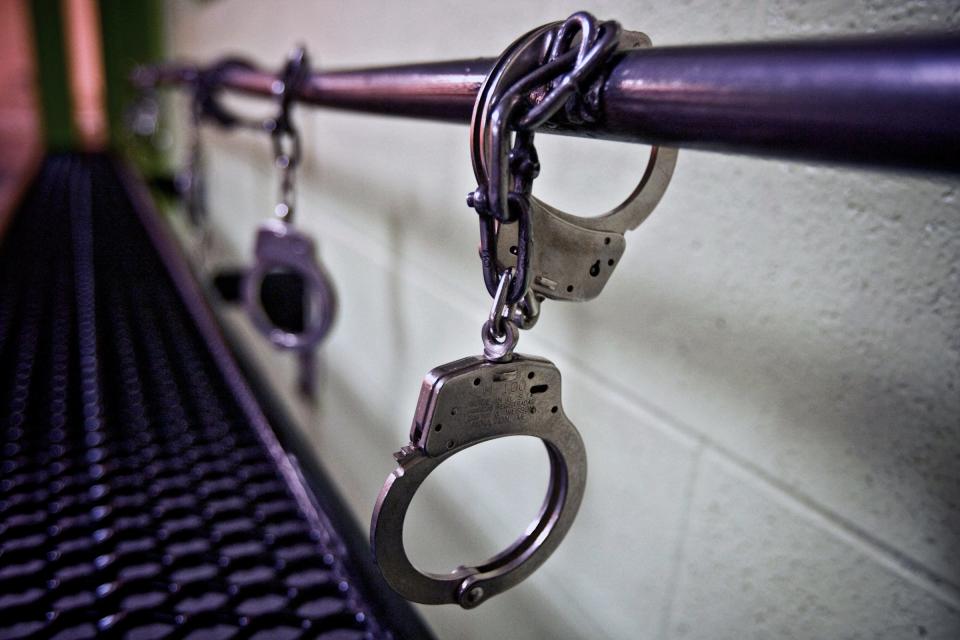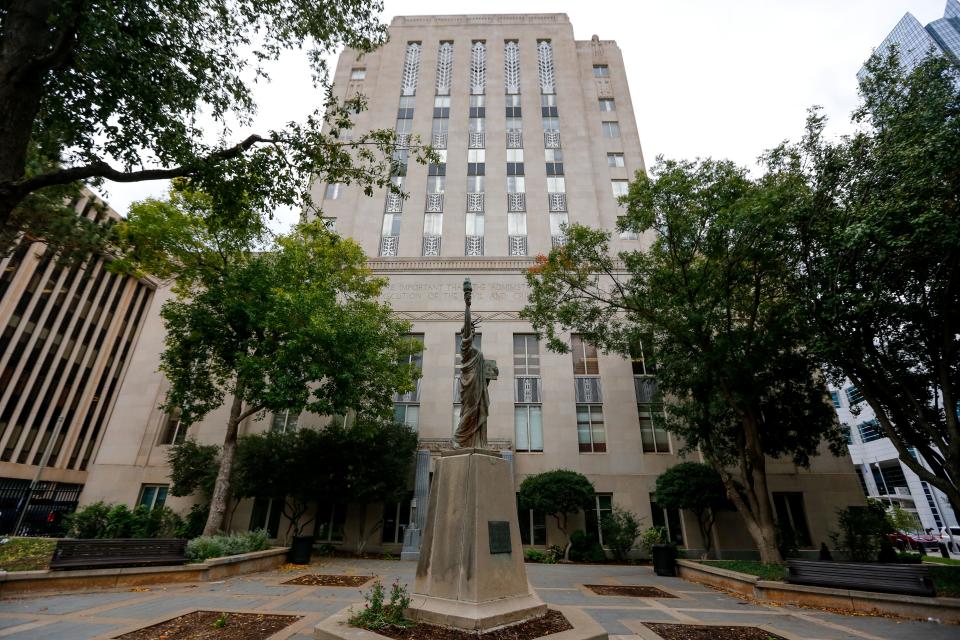Racial disparity persists at Oklahoma County jail despite overall population decrease

The population of Oklahoma County's jail is significantly lower than it was eight years ago, but racial disparity persisted among its population in 2022.
More Black detainees made up the jail's population than white detainees.
An outside analyst who identified that trend, among others, is making additional recommendations about what more can be done to create a fairer and more effective criminal justice system.
The Crime and Justice Institute's analysis was presented to interested members of the Greater Oklahoma City Chamber and community guests Wednesday, with the jail population's racial disparity issue generating some significant discussion.
More: Living Hell: The Oklahoma County jail
Terrell Johnson, a community intervention center team leader at Pivot, told a panel discussing the findings they weren't going to be able to accurately identify the cause just by discussing it among themselves.
Instead, Johnson suggested community leaders need to involve the county's Black population in the discussions.
"Without having a seat at the table or a voice in the conversation, it's a disconnect for them," Johnson said. "If they aren't part of those discussions, then we are not going to have a buy-in. People who have an investment and have a say-so on how they are treated will be incentivized to follow through on things.
"This is all about surviving. We shouldn't condemn them for that, but we should show them better ways to live."
Johnson's remarks were directed toward Oklahoma County District Attorney Vicki Behenna; Timothy Tardibono, Oklahoma County Criminal Justice Advisory Council executive director; Len Engel, director of policy and campaigns for the Crime and Justice Institute; and Christy Gillenwater, the president and CEO of the Greater Oklahoma City Chamber.
Behenna told Johnson she understood his concerns and said she is working on ways to make positive interventions in the lives of struggling county residents earlier to steer them toward programs and educational opportunities to help them live meaningful lives.
"Education is key to help lift someone out of poverty and out of hopelessness," she said.
The panelists were taking comments from audience members after watching a review of the institute's analysis of the long-troubled jail and broader criminal justice system in 2022. The jail has been cited for numerous health and safety violations by state and federal authorities over the past several years. More than 40 detainees have died at the jail since the trust took over in 2020.
More: The Oklahoma County Jail under the Jail Trust. A timeline of trouble

As part of that review, the institute evaluated six key recommendations the Vera Institute of Justice made to community leaders who made up the Greater Oklahoma City Chamber's criminal justice reforms task force in 2015.
Vera made the recommendations to address the jail's overcrowding and to improve public safety.
"What we were asked to do was to provide a progress report," Molly Robustelli, a policy manager with the Crime and Justice Institute (CJI), told guests at Wednesday's event.
A review of the jail's demographics found the jail's population had fallen from 2,414 on July 1, 2015, to 1,523 on July 1, 2022, Robustelli said. The jail's average number of detainees so far this month has been about 1,250, she reported.
Institute data shows the percentage of female detainees at the county jail fell from 17.5% in 2015 to 14.4% in 2022, an average more in line with national statistics, Robustelli said.

Data showed the number of jail admissions in 2022 was 44% lower than it was in 2015, but showed the percentage of the jail's detainees who are Black climbed to 44% in 2022, compared to just 39% for white detainees.
Just 16% of Oklahoma County's population is Black, but the data over that seven years showed that 37% of admissions into the jail were Black.
More: Commissioner: New jail to be 'night and day' improvement from current jail's problems
Evaluation on goals to improve Oklahoma County's criminal justice efforts showed mixed progress
County and civic leaders who participated in the reform task force in 2015 were given a list of six priority recommendations by the Vera Institute of Justice to improve its criminal justice services for residents.
Priority recommendations included:
Creating an oversight board: The Greater Oklahoma City Chamber worked with county and city officials to create the Oklahoma County Criminal Justice Advisory Council, which still exists and meets regularly.
Reducing jail admissions for municipal violations and low-level misdemeanors: CJI found the community made fewer arrests for municipal charges and drug- and alcohol-related misdemeanors. It also noted Oklahoma City Police Department's use of a cite-and-release policy for those types of crimes had increased 61% between 2015 and 2022.
Creating a fair and efficient pretrial release process that safely reduces unnecessary pretrial incarceration: CJI found 84% of detainees being held in the jail in 2023 had not yet been tried for crimes they were accused of, compared to a national average of 71%. It also found the county still sets strict eligibility standards for conditional or own recognizance releases and that arresting agencies often are still setting bond amounts for each individual complaint a person is arrested upon. Strategies that have not been implemented include expedited screening and assessment of detainees who could qualify for own recognizance or conditional releases, setting a single bond for detainees when they are accused of multiple crimes and to give detainees bail reviews at formal arraignments.

Identifying and addressing district court case processing delays that increase jail admissions and length of stay: CJI found some improvement here, but not for everyone. The jail released more than 22,000 detainees in 2023, with a third of those released within 48 hours. The average length of stay was 24.7 days. It found processes the county uses to notify individuals warrants have been issued for their arrests remains outdated. It also noted the jail has not found a way to give detainees earlier access to attorneys, doesn't offer self-surrender and that prosecutors are not triaging cases to expedite ways they are handled. Recommended measures to address the issue that have not yet been addressed include creating a program to notify released detainees when charges are filed or hearings are set in their cases, creating a triage program to identify cases that can be fast-tracked or diverted and prioritizing attorney access for detainees. The county has successfully launched a periodic warrant resolution program. One held in December helped more than 400 people clear both county and Oklahoma City municipal warrants they faced.
Expanding meaningful diversion program options, focusing on those with mental illness and substance use disorders: CJI found Oklahoma County's courts currently are operating nine different diversion programs that in late 2023 involved about 1,300 defendants, giving them alternatives to jail and prison sentences. It recommended the county work harder to get detainees involved in those programs earlier.
Reducing the impact of justice system fines and fees as a driver of jail growth and recidivism: Changes in state laws would be needed to make meaningful progress here.
Tardibono said more work remains before Oklahoma County's criminal justice system is as fair and equitable as it needs to be.
"We have another road map now that shows us things that didn't quite get done and where we can go the next five or six years to build on what we've accomplished," he told audience members after CJI concluded its presentation.
Meanwhile, Engel applauded local leaders for continuing their efforts to improve the county's criminal justice programs.
While many communities put together similar task forces to evaluate their problems, most end up as one-and-done looks that fail to gain traction, he said.
"What stands out here is that you guys are continuing to do this," Engel said. "Your commitment to continue doing this stuff is unique. I haven't seen this level of commitment sustained over this period of time anywhere else."
This article originally appeared on Oklahoman: Racial disparity persists at Oklahoma County jail, analyst says

